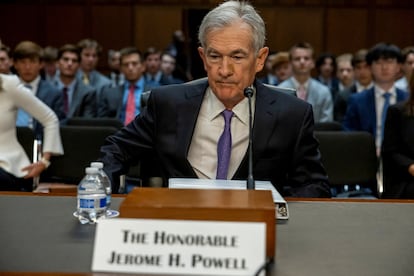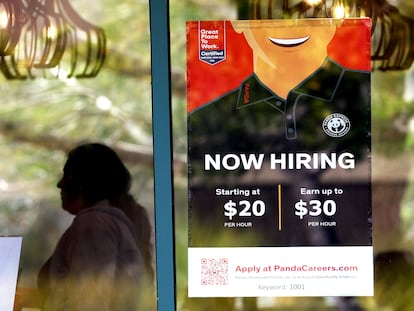The Federal Reserve lowers interest rates by 0.5 points and foresees additional cuts this year
Investors had been divided on whether the first cut of the new cycle would be aggressive or moderate


The U.S. Federal Reserve confirmed a change of cycle on Wednesday. The central bank has approved the first interest rate cut in four and a half years. Fed Chair Jerome Powell had already indicated that the time had come, a crucial turning point in which U.S. monetary policy shifts from fighting inflation to trying to avoid a recession. It was assumed interest rates would be cut, but it was not known by how much. Finally, the Federal Reserve chose to approve an initial cut of 0.5 points. In addition, Fed members anticipate that there will be more cuts imminently.
The Federal Reserve made quarter-point cuts during all three monetary policy easing cycles of the 1990s: in 1990, in response to the Gulf War recession; in 1995, the last precedent for a soft landing; and in 1998, in response to the financial crisis in Southeast Asia. So far this century, it responded with an initial half-point cut to the tech bubble crash of 2001. It also initially reacted with a 0.50-point cut to the 2007 bursting of the property bubble that led to the financial crisis and the Great Recession. It did the same with the Covid-19 pandemic in 2020, although one year earlier it had made three 0.25-point cuts in what Powell called a mid-cycle adjustment.
At the present time, the U.S. is not engaged in a war, there is no pandemic or declared recession, and inflation has not yet reached the 2% target. That, along with continued job creation, has long led most economists to believe that the Fed would be cautious with its first rate cut. At the same time, the central bank faces criticism from those who believe it is somewhat behind the curve, that it should have approved the first cut in July, something that some of its members were willing to do, as the records of that meeting later revealed.
The latest economic data released on Tuesday showed growth in retail sales. “The continued resilience of consumer spending suggests that fears about the health of the economy are overblown. We expect layoffs to remain modest, which will help keep the unemployment rate close to current levels in the coming months,” said analysts at Oxford Economics.
The Federal Reserve’s own members published their forecasts on Wednesday on where they think the unemployment rate, economic growth, inflation and interest rates will be at the end of this year and in the next few years. They paint a soft landing scenario in terms of economic indicators and of additional interest rate cuts.
Faced with inflation that turned out to be less transitory than expected, the Federal Reserve implemented its most aggressive rate hikes in four decades. Between March 2022 and July 2023, it approved 11 rate rises, taking the federal funds rate from near zero to the 5.25%-5.5% range it had been in until now. This was the highest level since January 2021.
After those 11 rate hikes, Powell decided for more than a year that the best thing to do was to do nothing. Rates have not budged since July of last year, despite the fact that the market was betting on a much earlier relaxation of monetary policy. The persistence of inflation weighed more on Powell than the progressive weakening of the labor market, especially while the unemployment rate remained below 4% and the inflation rate above 3%.
With Wednesday’s decision, the U.S. Federal Reserve joins other central banks around the world that have already begun the process of relaxing monetary policy in the wake of the global inflation crisis. The European Central Bank (ECB) cut interest rates for the second time last week. The Bank of England also lowered the price of money last month, although a pause is expected at its meeting on Thursday. The central banks of Canada, New Zealand, Mexico and China, among others, are also relaxing their monetary policy. The main exception is Japan, which recently raised rates, although they remain at very low levels. A change of pace is also expected in Brazil in the face of rising inflation.
Sign up for our weekly newsletter to get more English-language news coverage from EL PAÍS USA Edition
Tu suscripción se está usando en otro dispositivo
¿Quieres añadir otro usuario a tu suscripción?
Si continúas leyendo en este dispositivo, no se podrá leer en el otro.
FlechaTu suscripción se está usando en otro dispositivo y solo puedes acceder a EL PAÍS desde un dispositivo a la vez.
Si quieres compartir tu cuenta, cambia tu suscripción a la modalidad Premium, así podrás añadir otro usuario. Cada uno accederá con su propia cuenta de email, lo que os permitirá personalizar vuestra experiencia en EL PAÍS.
¿Tienes una suscripción de empresa? Accede aquí para contratar más cuentas.
En el caso de no saber quién está usando tu cuenta, te recomendamos cambiar tu contraseña aquí.
Si decides continuar compartiendo tu cuenta, este mensaje se mostrará en tu dispositivo y en el de la otra persona que está usando tu cuenta de forma indefinida, afectando a tu experiencia de lectura. Puedes consultar aquí los términos y condiciones de la suscripción digital.
More information
Archived In
Últimas noticias
Most viewed
- Sinaloa Cartel war is taking its toll on Los Chapitos
- Oona Chaplin: ‘I told James Cameron that I was living in a treehouse and starting a permaculture project with a friend’
- Reinhard Genzel, Nobel laureate in physics: ‘One-minute videos will never give you the truth’
- Why the price of coffee has skyrocketed: from Brazilian plantations to specialty coffee houses
- Silver prices are going crazy: This is what’s fueling the rally










































